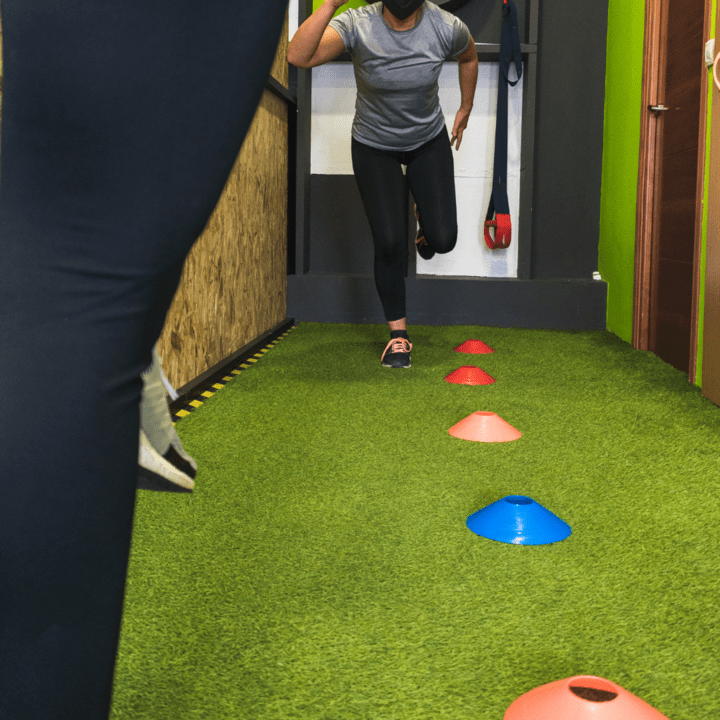Regular exercise is essential for living a long and fulfilling life. By exercising regularly, strengthening muscles, and limiting calories, you can resolve many, if not most, physical and mental health issues.
The advantages can also be seen in the eyes.
Physical activity helps some of the most threatening vision problems linked to diabetes, cholesterol, and blood pressure.
Additionally, exercise can help relieve eye strain and dryness associated with mental health issues.
RECOMMENDED GUIDELINES FOR EXERCISE:

According to the US Department of Health and Human Services, the majority of healthy adults should follow these exercise recommendations:
- 150-300 minutes of moderate aerobic exercise
- 75-150 minutes of vigorous aerobic exercise, or a mix of both during the course of a week.
- Two times per week strength exercises , two times per week, for 20 to 30 minutes that use several muscle groups in 12 to 15 repetitions.
- Additionally to continue moving and being active throughout the majority of the day.
Aerobic vs AnAerobic exercises :
Moderate-intensity aerobic exercises have well-known benefits. Anaerobic exercises are the most effective for weight loss, but are discouraged by people lacking anaerobic training.
AEROBIC EXERCISE:

Exercise that engages the cardio-respiratory system and are of low to moderate intensity is aerobic exercise. This causes your heartbeat to speed up and your breathing to become labored to the point where it becomes difficult to speak.
It basically means that your heart and lungs’ muscles are working hard to get oxygen to every cell in your body.
Examples include cycling, yoga, running, and walking.
Anaerobic exercises:

These are high-intensity exercises that should only be performed briefly.
This is typically appropriate for athletes and individuals who have engaged in consistent, intense exercise.
Here, glucose rather than oxygen serves as the primary energy source, making the situation anaerobic.
When you exercise vigorously for a brief period of time, your muscles must absorb glucose from the bloodstream in order to obtain the energy they need to complete the activity.
Examples include sprinting, strenuous weightlifting, pushups, etc.
INTERVAL TRAINING:
Periods of vigorous aerobic to anaerobic exercise, followed by periods of low intensity (rest or active rest).
For instance, high-intensity interval training (HIIT).
5 EYE BENEFITS OF REGULAR EXERCISE:
The human body is a single functional system.
It goes without saying that the other components will suffer if one isn’t working properly.
There is a strong link between a wide range of eye-related health conditions and some commonly occurring non-communicable diseases, including diabetes, hypertension, and high cholesterol.
The WHO recommends adopting a healthy diet and exercise routine to safeguard ourselves against such issues.
1. EYE PROBLEMS RELATED TO MENTAL HEALTH

Although stress is a common reaction to the demands of daily life and a normal part of life, when it becomes excessive or chronic, it can cause some serious health problems, including problems with our eyes.
Stress and anxiety can cause the body to release excessive amounts of adrenaline, causing blurred vision and increase in eye pressure. Long-term anxious people frequently experience eye strain throughout the day. Other symptoms include eye twitching, eye floaters, photosensitivity etc.
Mental health research suggests that regular exercise has anxiolytic effects on the amygdala, the part of the brain responsible for handling threat, panic, stress, and emotion. Regular exercise helps you stay calm and reduces anxiety.
2. DIABETIC RETINOPATHY

A person who is overweight and has an abnormal accumulation of subcutaneous and abdominal fat is at a high risk of getting type 2 diabetes or insulin resistance.
The National Institute of Diabetes and Digestive and Kidney Diseases (NIDDK) has found that approximately one in three diabetic patients older than 40 years have some changes in their retina related to high blood sugar.
A study demonstrates that a 10% weight loss significantly lowers insulin resistance.
Combining progressive vigorous exercise with strength training three times per week with calorie restriction will not only cause weight loss but may also improve insulin sensitivity. By absorbing and utilizing glucose more efficiently, the body improves its blood sugar levels.
Therefore exercise can help metabolize blood sugar as well as improve insulin resistance thereby decreasing the chances of diabetic retinopathy.
3. HYPERTENSIVE RETINOPATHY:
Regular aerobic exercise significantly lowers blood pressure in patients with essential hypertension. Higher intensity exercises may not be as effective at lowering blood pressure as mild to moderate exercise. In patients with severe hypertension and left ventricular hypertrophy who are receiving treatment, such exercise is also safe and effective in lowering blood pressure. Patients who have hypertensive retinopathy or are at risk for developing it benefit from this.
4. GLAUCOMA:
Exercise helps in glaucoma patient in two ways:

- Decrease in IOP: Elevated intraocular pressure (IOP) is the only modifiable risk factors for glaucoma. An immediate or short-term drop in IOP following exercise and a lower baseline IOP in glaucoma patients following light aerobic exercises suggest that exercise may actually have a beneficial effect on IOP.
- Neuroprotection: Several studies have demonstrated that aerobic exercise has neuroprotective properties. Regular aerobic exercise causes the body to release BDNF, or brain-derived neurotrophic factors, which promote neurogenesis and slow down or stop the loss of RGCs (Retinal Ganglion Cells).
There has been a link between exercise and neuroprotection in the past for age-related neurodegenerative diseases like Alzheimer’s and vascular dementia. Current data points to a similar protective role for exercise in the development of eye disease.
5. AMD:

People over 50 are more likely to develop AMD, or age-related macular degeneration, when the macula, or central area of the retina that produces straight-ahead vision, is damaged. Thus, the central vision is impaired while peripheral or side vision remains unaffected.
Several mechanisms have been proposed that may contribute to its progression. These mechanisms include oxidative stress and dysregulation of the complement cascade.
Some of the modifiable risk factors include obesity, unhealthy diet, sedentary lifestyle, smoking, hypertension, high cholesterol and sunlight exposure.
The development of macular drusen, precursors to AMD, may be accelerated by physical inactivity, and inflammation and endothelial dysfunction may worsen AMD.
Thus, consistent moderate exercise and other lifestyle changes help to lose weight, maintain healthy blood pressure and lipid levels and have an antioxidant effect, all of which may slow the progression of AMD
QUICK SUMMARY
Making exercise a priority in daily life is essential. Regular exercise at a moderate pace can help treat or even prevent some of the most disabling medical conditions. As part of their strategy for treating eye diseases, eye specialists should encourage exercise in addition to the use of medications.
